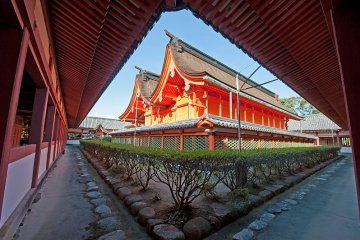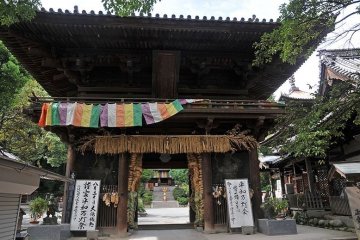
Festival Dogo Onsen 2026
Bronwyn O'NeillChaque année au mois de mars, Dogo Onsen se pare de lanternes et de rayures rouges pour célébrer son histoire culturelle et devient le lieu de rassemblement de la population locale.

Dogo Onsen est situé dans le centre de Matsuyama et est l'une des plus anciennes sources chaudes du Japon. La maison principale "Honkan" est la partie la plus connue de l'onsen et est située dans le centre-ville. Ce bain public en bois date de 1894 (période Meiji) et est considéré comme l'une des inspirations du célèbre film d'animation " Le Voyage de Chihiro".
Le Honkan est un atout culturel japonais important et est régulièrement entretenu pour conserver sa structure d'origine. Le bâtiment de trois étages a été conçu par Matahachiro Skamato, un maître dans son domaine qui a également participé à la conception du château de Matsuyama. Dans le Honkan, vous trouverez deux zones de baignade, le Tama no Yu et le Kami no Yu.
la maison de bain Tsubaki no Yu La maison de bain a été construite en 1953 et a incorporé le tsubaki (camélia) dans sa conception, qui est le symbole de la ville de Matsuyama. Depuis sa construction, c'est l'un des bains publics les plus populaires de la ville car l'eau utilisée provient de sources 100% naturelles. De plus, le Tsubaki no Yu présente un design intérieur particulièrement beau et propose des salles de bains intérieures séparées.
L’annexe Asuka no Yu Bath house, contrairement aux autres bains, est un bâtiment nouvellement construit, qui a été ouvert en 2017. Il a été nommé d'après le style architectural de la période Asuka et a été conçu pour se fondre dans le paysage urbain. Contrairement au Honkan, le bain Asuka no Yu dispose de bains extérieurs et compte également des bains privés (similaires au Yushinden, le bain privé utilisé par la famille impériale dans le Honkan).
Attention (!) La fin des travaux de rénovation du bâtiment est prévue pour 2024. Pendant la première phase, deux salles de bains au rez-de-chaussée resteront ouvertes, tandis que les étages supérieurs seront fermés. Veuillez noter que certaines parties du bâtiment peuvent être temporairement recouvertes d'échafaudages ou de feuilles.

Chaque année au mois de mars, Dogo Onsen se pare de lanternes et de rayures rouges pour célébrer son histoire culturelle et devient le lieu de rassemblement de la population locale.

Denpun est un restaurant situé dans un ancien wagon bleu et jaune de petite taille sur les berges de l'Isshite, entre l'Isshitei-ji et l'Onsen d'Okudogo. Il propose une fusion espagnole délicieuse et fraiche, servie avec style à un prix très bas.

Thought to be at least 1,000 years old, Isaniwa is one of Japan’s three shrines dedicated to the deity Hachiman. After climbing a long stretch of stone stairs, passing a double-story gate, a magnificent bright-red structure emerges. The architectural details are especially grand with the building’s swooping tile roofs, gold-leaf columns and ornate, cloudlike beam engravings. In addition to the spectacular architecture, there are displayed paintings of warriors and warfare (as Hachiman is the guardian of warriors and protector of Japan) and even numerous documents on Japanese mathematics. A hall of treasures features swords and armor for samurai history buffs. Other relics include animal paintings and calligraphy. Supposedly, Isaniwa Shrine originally marked the location where Emperor Chuai and Empress Jingu, who reigned in the third century AD, bathed at one of Japan’s oldest bathhouses, Dogo Onsen, now just a few hundred meters away. The shrine was moved to by the Kono samurai clan in the fourteenth century to the current location where, after conquering the stairs, you can enjoy breathtaking views of Matsuyama city. It was rebuilt in the 17th century by the Matsudaira clan; the current buildings with their great vermilion surface date from 1667. The original imperial bathers are enshrined there. Despite its age, the shrine is still buzzing with worshippers and even couples celebrating or taking pictures for their wedding. Although visitors note that the stairs are a little treacherous, the views and tranquil atmosphere only add to the experience of walking around the colonnade and absorbing a rich and long history—and if you’re lucky, observing a modern-day ceremony. If the trip does tire you out, you can always relax at Dogo Onsen at the foot of the compound.

At Matsuyama’s most famous temple, a sight almost as guaranteed as the temple buildings themselves is the cadre of pilgrims in white traveling the Shikoku Pilgrimage, a circular 88-site, 1200-kilometer circuit. Whether you’re at Ishiteji for religious, ascetic or sightseeing reasons, the compound is sprawling and quite unusual. On both sides of Niomon Gate (a National Treasure) are two monumental straw sandals, promising relief for those suffering with painful leg conditions. As you reach the main area, you’ll be greeted by even more curiosities. Stroll through the main hall, itself lined with vibrant panel paintings, enter a cave and you reach yet another temple. This inner structure resembles a large golden bead and contains a famously eclectic collection of sculptures, carvings and paintings. Particularly arresting are the images of the skeletal historic Buddha in the period before his enlightenment. Accompanying these are countless Kannon figures, dwarves, demons and deities. Kobo Daishi, a famous Buddhist monk who supposedly originated the Shikoku Pilgrimage, is immortalized in a towering statue on a nearby forested hill. On top of its treasure-packed halls, a three-story pagoda occupies the main grounds. Ishiteji, which literally means “stone hand temple,” has an origin story as unique as its contents. A man had wronged Kobo Daishi and, wanting to atone, established the path of the Shikoku Pilgrimage in search of the monk. When they finally met, Kobo forgave him and gave him an inscribed stone with which he was buried. Then a boy was born with a stone clenched in his hand; this boy came to build Ishiteji. The legendary stone is still in a small museum on the compound, surrounded by no shortage of similarly precious relics, treasured buildings and, supposedly, people’s souls. If Ishiteji Temple proves to be sensory overload or a tiring trek, historic Dogo Onsen is a few minutes away.

Most might not expect to find a French-style villa below Matsuyama Castle, but this elegant construction offers a respite from the bustling town center of Ehime. Bansuiso, largely hidden by trees and modern buildings, was originally the second Residence of Count Hisamatsu Sadakoto, a descendant of the Matsuyama samurai clan and former lord of the neighboring castle. After living in France and returning with his love of Neo-Renaissance architecture, he commissioned the construction of the villa. Completed in 1922, it was the scene of numerous elite parties and social gatherings, and even welcomed members of the imperial family as guests, including Showa Emperor Hirohito. Bansuiso serves as both a place of art and culture and a sight. The first floor and the basement are freely accessible and for ¥ 300 visitors can climb a wooden staircase to take advantage of more photo opportunities. Although the villa hosts solo exhibitions, it also has its own murals and portraits, including the portrait of the first owner.